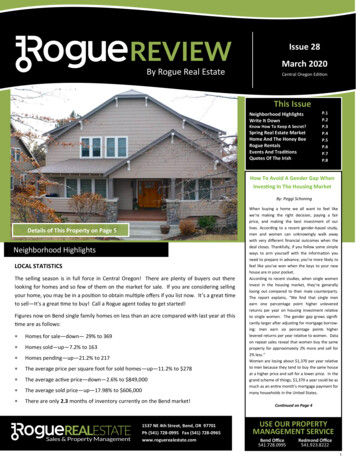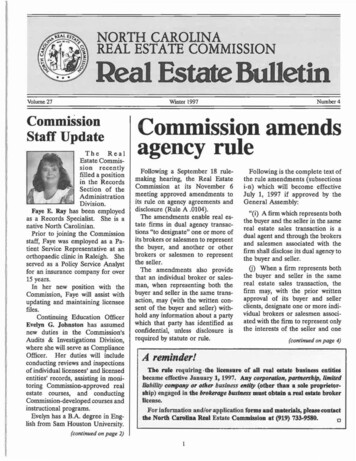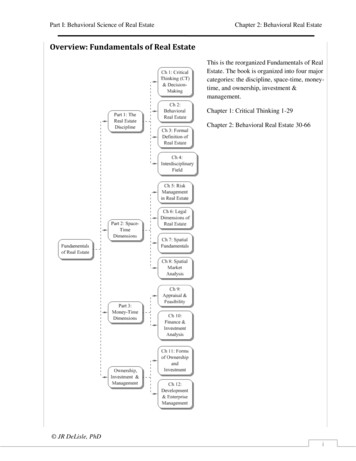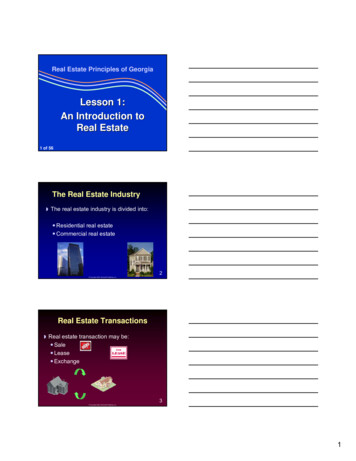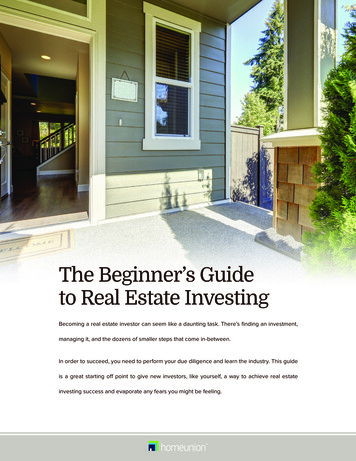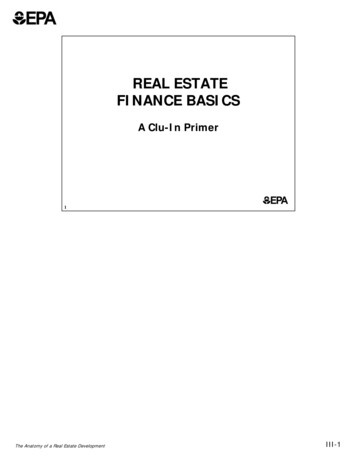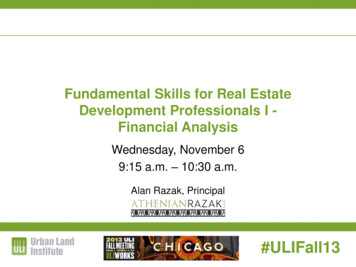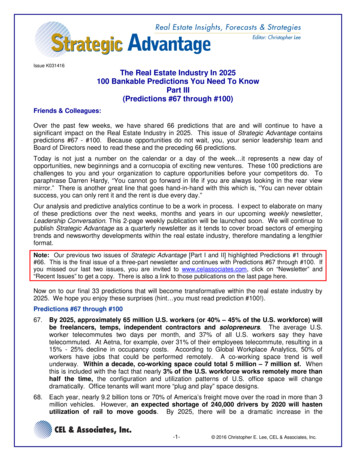
Transcription
Issue K031416The Real Estate Industry In 2025100 Bankable Predictions You Need To KnowPart III(Predictions #67 through #100)Friends & Colleagues:Over the past few weeks, we have shared 66 predictions that are and will continue to have asignificant impact on the Real Estate Industry in 2025. This issue of Strategic Advantage containspredictions #67 - #100. Because opportunities do not wait, you, your senior leadership team andBoard of Directors need to read these and the preceding 66 predictions.Today is not just a number on the calendar or a day of the week it represents a new day ofopportunities, new beginnings and a cornucopia of exciting new ventures. These 100 predictions arechallenges to you and your organization to capture opportunities before your competitors do. Toparaphrase Darren Hardy, “You cannot go forward in life if you are always looking in the rear viewmirror.” There is another great line that goes hand-in-hand with this which is, “You can never obtainsuccess, you can only rent it and the rent is due every day.”Our analysis and predictive analytics continue to be a work in process. I expect to elaborate on manyof these predictions over the next weeks, months and years in our upcoming weekly newsletter,Leadership Conversation. This 2-page weekly publication will be launched soon. We will continue topublish Strategic Advantage as a quarterly newsletter as it tends to cover broad sectors of emergingtrends and newsworthy developments within the real estate industry, therefore mandating a lengthierformat.Note: Our previous two issues of Strategic Advantage [Part I and II] highlighted Predictions #1 through#66. This is the final issue of a three-part newsletter and continues with Predictions #67 through #100. Ifyou missed our last two issues, you are invited to www.celassociates.com, click on “Newsletter” and“Recent Issues” to get a copy. There is also a link to those publications on the last page here.Now on to our final 33 predictions that will become transformative within the real estate industry by2025. We hope you enjoy these surprises (hint you must read prediction #100!).Predictions #67 through #10067.By 2025, approximately 65 million U.S. workers (or 40% – 45% of the U.S. workforce) willbe freelancers, temps, independent contractors and solopreneurs. The average U.S.worker telecommutes two days per month, and 37% of all U.S. workers say they havetelecommuted. At Aetna, for example, over 31% of their employees telecommute, resulting in a15% - 25% decline in occupancy costs. According to Global Workplace Analytics, 50% ofworkers have jobs that could be performed remotely. A co-working space trend is wellunderway. Within a decade, co-working space could total 5 million – 7 million sf. Whenthis is included with the fact that nearly 3% of the U.S. workforce works remotely more thanhalf the time, the configuration and utilization patterns of U.S. office space will changedramatically. Office tenants will want more “plug and play” space designs.68.Each year, nearly 9.2 billion tons or 70% of America’s freight move over the road in more than 3million vehicles. However, an expected shortage of 240,000 drivers by 2020 will hastenutilization of rail to move goods. By 2025, there will be a dramatic increase in the-1- 2016 Christopher E. Lee, CEL & Associates, Inc.
construction of warehouse/distribution facilities along, adjacent or near to rail lines. PerhapsWarren Buffet’s 26.5 billion buyout of BNSF railroad is a precursor that investors seetremendous upside. Today the U.S. freight industry is around a 60 billion industry consisting of140,000 rail miles. Expect a significant increase in shipping by rail over the next 10 years.69.There are 70 million – 80 million dogs and 74 million – 96 million cats in the U.S. The petindustry is nearly a 60 billion industry and approximately 62% of households have a pet,with 46% of households having more than one pet. Approximately 37% – 47% of all U.S.households have a dog, and 30% – 37% have a cat. By 2025, it will be common to see dogs inworkplace environments and pet sitters/walkers a common feature in apartment and officebuildings. Expect to see growth in luxury pet spas, arranged pet play dates, expansion ofpremium services and specialized products and services.70.By 2020 (barring a major recession), interest rates may increase by 225 bsp – 250 bsp ormore; and by 2025 interest rates could be up nearly 250 bsp – 350 bsp from their 2015low. The prime rate, according to analysts, is expected to rise from 3.5% today to around 6% by2025. Any rise in borrowing rates for consumers or for real estate investments will have adampening impact on transactional volume and pricing. Do not be surprised to see interest ratesrise and then slide back to 2014 – 2015 levels over the next decade before they rise again.71.Today 21% of Americans are “on-the-run” eaters. Two-thirds of them are female, and 51%are in one- or two-person households. This 90 billion industry provides convenience and value.Over the next decade, the growth of companies such as Blue Apron, Plated, Hello Fresh andHome Chef will capture a portion of this growing segment. Grocers such as Whole Foods,Kroger, Safeway and Publix, among others, are expanding the fresh food meal options. Withina decade, nearly 30% – 35% of Americans will be on-the-run eaters, and nearly half oftoday’s on-the-run eaters will be between the ages of 30 and 56. Grocery stores must adddrive-through windows, make-a-meal Internet options (pick-up or delivered) and other on-the-gomeal options.72.Within a decade the U.S. will face a retirement crisis. The percent of workers covered by atraditionally defined benefit pension plan that pays a lifetime annuity has declined from 38% to20%. The percentage of workers in the private sector whose only retirement is a definedpension plan is now 10%, down from 60% in the early 1980s. A staggering 68% of working-agepeople (25 – 64) do not participate in an employee-sponsored plan. Only 7% of Fortune 500companies offer traditional pensions to new hires. According to recent studies, the U.S.retirement savings deficit is between 6.8 and 14 trillion. Forty-five percent of workingage households do not have any retirement account assets. According to FidelityBrokerage, a couple retiring in 2015 with average life expectancies of 85 for a male and 87 for afemale will have 250,000 in healthcare costs. Only 22% of today’s workers are very confidentand 36% are somewhat confident that they will have enough money in retirement. Twenty-eightpercent of workers have no retirement savings. For the real estate industry, the retail assets notconsidered “essential” will suffer. Affordable housing (senior and conventional) and self-storagewill flourish.73.Today there are around 15 million single-family rental housing units and another approximately 8million two-to-four family homes. Thirty-four percent of single-family rentals are in center cities.Approximately 25% of all center city households spend over 50% of their income on rent.A projected 59% of new households formed between 2010 and 2030 will be renters. By 2025,the U.S. homeownership level will have declined to a percentage of around the mid- to high 50s,the percentage of single-family rentals will increase and the number of renters over the age of65 could reach 50% of the overall renters growth.74.Over 50% of Americans have rented, leased or borrowed cars, bikes, tools, appliances, clothingand homes in the past year. In the next decade, expect that to rise to 75% as “dis-ownership”and ride-sharing become the norm. By 2025, the sharing economy worldwide could exceed 335 billion. The impact on retail real estate will be significant. Apartment buildings will be-2- 2016 Christopher E. Lee, CEL & Associates, Inc.
require to have/add “storage” features (on-site or off-site) to aid this new collective consumerlifestyle within an ever-shrinking and confined environment.It Happens By 2025!1.The Utica Shale Basin in Pennsylvania, West Virginia and Ohio (potentially the nation’s largest untappednatural gas reserve) could spell a real estate and economic boom for their area.2.Robotics could be the engine that drives an economic boom to Ohio and the Midwest. It isn’t aboutjobs it is all about production (mostly computers, electronics, chemicals, automotive and appliances).3.The Internet of Everything will exceed 100 billion devices and generate 19 trillion in newly created value.4.Watch for Apple, Microsoft, Google, SAP and others to enter the healthcare industry creating“democratized healthcare.”5.Blockchain technology will be perfected by 2025 that will transform how Americans and the world stores,accesses and interacts with data from bitcoin transactions.6.By 2025, we will have observed the first humans to “hack” their own bodies through brain-enhancingdrugs and wearable technologies.7.Within a decade, we could see 15 – 25 country “mergers” to serve and save their economic futures.8.Over 50% of the world’s largest, publically-traded companies in 2025 did not exist in 2015.9.By 2025, leading hotel firms will be able to stimulate and simulate the experiences of their hotel (smell,feel, taste and experience), from a mobile phone or computer.10.Genome engineering will be able to prevent Type I and Type 2 diabetes.11.By 2025, all forms of petroleum-based packaging will be gone replaced by biodegradable alternatives.“There will be at least one major cyber-attack that could resultin lives lost and billions of dollars in losses.”75.Within a decade, the number of public real estate investment trusts will continue theirconsolidation or shift from a public to a private enterprise. The primary drivers will be taximplications, compensation issues and reluctant leadership. There are around 150 public-equityREITs with a market cap over 1 billion, 42 with a 5 billion to 10 billion market cap and 20REITs with a market cap over 10 billion. By 2025, the number of REITs with a market capover 10 billion will double.76.Watch for Google to increase ownership and/or control over Auction.com. ExpectAuction.com to pursue an IPO over the next few years. While Google Capital says it has “noplans” to acquire Auction.com, the information/data reservoir and market dominance couldchange that thinking over the decade. Expect continued accelerated growth in online real estateauctions, possibly including leases.77.By 2025, the real estate industry should see the first of many “floating cities” underconstruction with a 2030 date for occupancy. As many as 5,000 people will live in each city.The Shimizu Corporation (“Ocean Spiral”), the Seasteading Institute, and the Chinesegovernment could be the first adapters. By 2050, there could be as many as 1,000 floatingcities. CBRE and others may open an “Aquatic Leasing Division.”78.Watch for a National Carbon Footprint or Ecological Footprint Rating on all real estate(re)development projects. Real estate developers will need to achieve a “minimum” score toreceive building permits or pay a large fine or tax on the building’s inefficiency.-3- 2016 Christopher E. Lee, CEL & Associates, Inc.
79.Tenants increasingly will demandservice clauses and service standardsin lease agreements. We will see ashift by 2025 from leasing space toleasing a workplace environment.From lighting to HVAC, from noise tocleanliness and from safety to security,real estate owners should “step uptheir game” to compete for valuedtenants.Every best–in-class officebuilding owner and operator will have aWorkplace Environment Specialist onstaff to engage each Tenant in creatinga positive, motivating environment.Think what would happen if the RitzCarlton, Langham Hotels, the FourSeasons or Marriott were the onsiteproperty management.80.By 2025, over 75% of employees at every real estate service company will have at leastone certification or designation (MBA, USGBC, CPM, CCIM, CRE, MAI, CRB, CRS, ALC,ARM, CRP or SRES). Watch for national or state legislation to mandate some form ofdesignation or certification to work as an Asset Manager, Property Manager, Leasing Agent orMaintenance Associate by 2025.81.Watch for the emergence of one or more real estate enterprises that will specialize in securing,controlling and leasing water rights, waste disposal, carbon credits, farming rights, energyproduction and/or ocean aquaculture. Control the site and you control the outcome.However, the debate on who owns riparian and flowing underground water could be incontinuous litigation until 2025.82.By 2025, a new wave of construction technologies and processes will reduce the timerequired to complete a construction project by 20% - 30%, reduce labor costs by 30% 40% and dramatically reduce (60% - 70%) materials inefficiency. Modular buildingtechnologies will flourish among infill properties, free-standing buildings, clinics, retail facilities,and “local” free-standing business office buildings. The tower at PNC Plaza in Pittsburgh or theEdge office building in Amsterdam are examples of the latest trends for smart buildings. In Pau,France, modular construction has created a student dorm facility with rooms of 507 sf. Someleading sustainable, prefab housing firms to watch over the next decade are LivingHomes,Connect:Homes, Stillwater Dwellings and Method Homes.83.The Hispanic population (around 55 million today) will remain concentrated in three states:California, Texas and Florida. By 2025, those states will be home for over 50% of all U.S.Hispanics. With a median age of 29, this growing demographic sector had 1 trillion buyingpower in 2015. By 2025, Hispanics could account for as much as 15% of total U.S. buyingpower. Within a decade, Hispanic wealth will triple to between 2.5 and 4.4 trillion or2.6% - 3.2% of the U.S. total wealth. By 2025, there will be nearly 60 million Hispanics inthe U.S. The opportunities for real estate investors and developers are unlimited. Fromapartments (54% rent), single-family homes (only 46% of Hispanics own their home), groceryanchored retail centers to out-patient healthcare facilities, real estate companies should notoverlook this growing segment of the U.S. population.84.Foreign investors purchased approximately 70 - 73 billion in commercial and multifamilyassets during 2015. The growing strength of the U.S. economy, the low interest rateenvironment, liquidity, transparency and global instability are some major drivers of this capital-4- 2016 Christopher E. Lee, CEL & Associates, Inc.
trend. Over the next decade, foreign investors will continue to be 20% - 30% of the buyersof U.S. real estate assets.85.Sustainability, energy conservation and recycling will be ongoing priorities of real estate firmsthrough 2025. Today, there are more than 200,000 LEED professionals and nearly 30,000LEED-certified commercial projects (4.25 billion sf). Over 100 billion of green materials will beused over the next decade. By 2025, there will be over 300,000 LEED professionals, morethan 100,000 LEED-certified commercial projects and over 5 billion sf of LEED-certifiedprojects.86.“Water, water everywhere but not a drop to drink.” Over the next decade, expect watershortages to impact the “desirability” of several U.S. cities. Markets such as Los Angeles,Tucson, Atlanta, Las Vegas, Ft. Worth, Phoenix, San Antonio, the San Francisco Bay Area andHouston are expected to face severe water shortages in the relative near-term. The impact onreal estate assets (landscaping, cleaning, air conditioning, water amenities or features andbuilding operations) will be significant. Expect legally mandated restrictions that coulddramatically impact the workplace, living and shopping environments. Investors should be verycareful when investing in markets likely to experience shortages of “natural” resources.87.Within a decade the rapid decline/presence of“city fathers,” who cared about the communityin which they lived and started/grew theirbusiness, will create an urban void that iscommoditizingseveralU.S.cities.Successful cities in 2025 will be anexpression of collective and concernedwill. Cities today, where core assets are 50%- 70% or more owned by entities/investorsresiding thousands of miles away, can neveractualize this collective civic commitment.Legacy real estate leaders, prior to 2000,contributed regularly to causes and activitiesthat improved communities. In the absenceof real estate leaders who created andenhanced the community through theirbuildings and philosophy, politicians attemptto fill the void. By 2025, unless this patternchanges, 65% of the largest cities in America may lose their collective community appeal.88.The de-industrialization within the U.S. will continue through 2025. The Institute for SupplyManagement’s Purchasing Managers Index is around 50, while exports are around 47 – 48, bothstrong indicators of a changing marketplace. U.S. exports are declining, and U.S. factorycapacity is around 77 (anything below 80 is considered weak factory output). There are earlysigns of a protracted slowdown that will not emerge until the early 2020s.89.The “Voice of the Customer” will carry more value and weight in the growth andreinvestment decisions of real estate companies over the next decade. The customerexperience, the ease of the customer interaction, social media chatter and building customerloyalty will be cornerstones for success. CEL & Associates, Inc., the nation’s largest surveyor oftenant, resident and client opinions in the real estate industry, has found a significant differencein operating performance between buildings with satisfied occupiers and those who are not.Real estate firms that cannot cover annual overhead expenses with the profits from recurring,satisfied clients will struggle. By 2025, best-in-class real estate firms will generate profitsfrom recurring clients that cover 100% of corporate overhead.-5- 2016 Christopher E. Lee, CEL & Associates, Inc.
90.Expect significant tax reform, unlikely to occur until 2021 or beyond. Tax reform will not occurprior to a Presidential election (2016 and 2020). The biggest impending tax impact will be theself-employment tax. If by 2020, 40% or more U.S. workers will be classified as “contingent”workers (1099s and “onetrepreneurs”), paying taxes quarterly will be a major challenge formany. This tax rate generally will be 30% of last year’s income, plus 15% for FICA. Justimagine what Brokers will have to pay with no guarantee that last year’s commissionswill be duplicated in the current year. There will be a growing trend to put Brokers on thepayroll to retain and motivate talent.91.In 2015, approximately 28% of Millennials were married. This is dramatically below the nearly64% of the Silent Generation at the same stage in their lives. About half of Baby Boomers and38% of Gen Xers were married when their generation was ages 18 to 33 years. By 2025, manyof these unattached Millennials will become renters by choice. It is clear that the Gen Zs(born in the late 90s and early 2000s) will continue America’s shift to a rental-based society.92.By 2025, a growing number of U.S. businesses will move downtown to: Attract and retain the best and the brightest talent. Locate proximate to walkable services and amenities. Build brand identity and company culture from being “in the center of things.” Support and encourage creative collaboration. Centralize operations and reduce overall operating costs. Be closer to customers, strategic partners, lenders, financial intermediaries andcompetitors. Generate greater results while investing in the community.Cities that are vibrant and gateways to business networking, smart growth, arts andentertainment, multi-modal transportation and support public-private partnerships will flourishover the next 10 years. Innovation will be one of the key market drivers for economic growthover the next decade. Cities and areas like Seattle, Nashville, Salt Lake City, Denver, Austin,Dallas, Minneapoli
Over the next decade, the growth of companies such as Blue Apron, Plated, Hello Fresh and Home Chef will capture a portion of this growing segment. Grocers such as Whole Foods, Kroger, Safeway and Publix, among others, are expanding the fresh food meal options. . Auction.com to pursue an IPO
